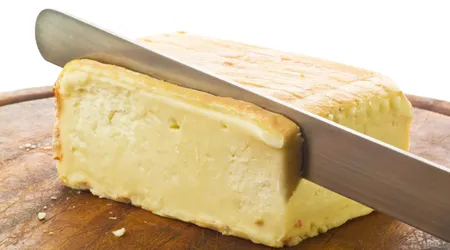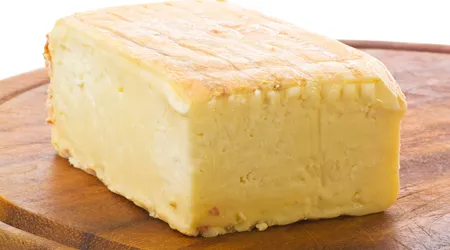Taleggio: How to Pair and Store It Correctly
The Taleggio, a soft cheese with a strong character and a fascinating history, is a jewel of the Italian dairy tradition.
Announcements
Originating in the Taleggio Valley in Lombardy, this PDO cheese is distinguished by its washed rind and creamy center, which releases intense aromas and flavors ranging from sweet to slightly spicy.
But how can we best showcase this gastronomic treasure?
How to pair it to enhance its qualities and preserve it to preserve its freshness?
In this article, we'll explore with intelligence and creativity how Taleggio can become the star of your culinary experiences, offering practical advice, original ideas, and in-depth information.
Announcements
Why is Taleggio special?

Taleggio is not just a cheese, but a sensory journey that tells the story of the Lombardy region.
Its moist, slightly rough orange rind hides a soft, melt-in-the-mouth texture, offering a perfect balance of sweetness and herbaceous notes.
Made from cow's milk, Taleggio matures for at least 35 days in humid caves, where it develops its characteristic aroma.
This artisanal process makes it unique, but it also requires a certain amount of attention to fully appreciate it.
Compared to other soft cheeses, such as Brie or Camembert, Taleggio stands out for its versatility.
It is neither overly delicate nor too aggressive, which makes it a perfect ally for many combinations, from classic to more daring.
For example, its ability to blend with structured wines or to contrast sweet flavors makes it an ideal ingredient for both hot dishes and raw tastings.
But have you ever wondered: how can such a simple cheese transform into an extraordinary gastronomic experience?
According to a survey conducted in 2024 by the Association of Italian DOP Cheeses, Taleggio is among the most exported Italian cheeses, with a 12% increase in foreign sales over the last five years.
This data reflects not only its popularity, but also the growing curiosity about its use in international cuisines.
++ How to store cheese correctly
However, to fully enjoy it, it is essential to know the preservation techniques and pairings that enhance its qualities without overpowering them.
How to Pair Taleggio: Creative and Smart Ideas

Classic pairings with a modern twist
Taleggio pairs beautifully with ingredients that balance its richness.
A traditional pairing includes serving it with fruit jams, such as fig or pear jam, which contrast its creaminess with a natural sweetness.
However, for a contemporary twist, try serving Taleggio on a slice of toasted rye bread, with a compote of caramelized red onions and a pinch of fresh thyme.
This mix creates a balance between the intense flavor of the cheese, the sweetness of the onions and the aromatic freshness of the thyme, perfect for a sophisticated aperitif.
Another interesting pairing is with chestnut honey, which with its bitter and robust notes amplifies the complexity of Taleggio.
For an even more original experience, consider pairing it with an amber craft beer: its light carbonation and hints of roasted malt cleanse the palate, preparing every bite for a new discovery of flavors.
These pairings demonstrate how Taleggio can be the cornerstone of combinations that satisfy both traditional and more experimental palates.
An original example?
Try the Taleggio in a hazelnut crustFinely chop some toasted hazelnuts and use them to cover a slice of Taleggio, then heat it slightly in the oven to melt the surface slightly.
++ Italian Cheeses: A Basic Guide
Serve with Granny Smith apple slices: the crisp acidity of the apple balances the fattiness of the cheese, while the hazelnuts add a surprising texture.
This dish is an ode to creativity, simple to prepare but capable of surprising guests.
Wine pairings: an art to master
When it comes to wines, Taleggio requires a careful choice.
A full-bodied red wine, such as a Barolo or Nebbiolo, can enhance the cheese's earthy notes, but be careful: a wine that's too tannic risks overpowering it.
An interesting alternative is an aromatic white, such as a Gewürztraminer, which with its floral and spicy notes creates an intriguing contrast with the creaminess of the Taleggio.
The key is to find a balance: the wine must accompany, not dominate.
For those who love to experiment, a passito wine, like a Recioto della Valpolicella, can be a bold choice.
The concentrated sweetness of the wine intertwines with the savouriness of the Taleggio, creating an experience that is almost a dance of flavours.
Imagine Taleggio as a leading actor on the stage of taste: the right wine is its partner, capable of enhancing it without stealing the show.
A creative example?
Prepare a Taleggio and pear tartine in red wineCook pear slices in a red wine spiced with cinnamon and cloves, then arrange them on a bed of melted Taleggio cheese.
This dish combines the sweetness of the fruit, the delicate spiciness and the creaminess of the cheese, creating a harmony that amazes with its refinement.
Taleggio in the kitchen: beyond the cutting board
Taleggio is not just a cheese to be enjoyed, but a versatile ingredient in the kitchen.
Its ability to melt makes it perfect for hot dishes, such as risottos or gratins.
For example, a Taleggio risotto with porcini mushrooms is a classic that never disappoints: the cheese adds an enveloping creaminess, while the mushrooms enhance its earthy notes.
However, to prevent the Taleggio flavor from overpowering, use a small amount and balance it with fresh ingredients, such as parsley or lemon zest.
Alternatively, Taleggio can be the heart of more creative dishes.
Try using it to stuff homemade ravioli, pairing it with a light butter and sage sauce: the simplicity of the sauce allows the cheese to shine without weighing down the dish.
Or, use it to enrich a white pizza with red onions and rosemary, where its creaminess blends with the crunchiness of the base.
An original idea?
Create a Taleggio and pumpkin cream to accompany croutons or grilled vegetables.
Bake some pumpkin, blend it with melted Taleggio cheese and a pinch of nutmeg, then serve the cream warm.
This dish is an example of how Taleggio can be transformed into a sophisticated condiment, capable of elevating even the simplest ingredients.
| Pairing | Ingredient/Drink | Main feature | Ideal opportunity |
|---|---|---|---|
| Fig jam | Natural sweetness | Balance the creaminess | Elegant aperitif |
| Amber beer | Notes of toasted malt | It cleanses the palate | Informal dinner |
| Gewürztraminer | Floral scents | Counteracts the saltiness | Refined tasting |
| Pear in red wine | Spicy sweetness | Enhances complexity | Creative appetizer |
How to store Taleggio: techniques to preserve its flavor
The importance of temperature
Storing Taleggio correctly is essential to maintaining its organoleptic qualities intact.
This cheese, with its lively rind and soft texture, is particularly sensitive to changes in temperature and humidity.
Ideally, it should be stored at a temperature between 4°C and 8°C, preferably in the lowest compartment of the refrigerator, where humidity is controlled.
Avoid leaving it at room temperature for more than an hour, as heat accelerates ripening and can alter its flavor.
A common mistake is wrapping Taleggio in cling film.
This material prevents transpiration, promoting the formation of unwanted mold and altering the crust.
Instead, use cheese paper or parchment paper, which allows the cheese to “breathe” while maintaining optimal moisture.
If you don't have any special paper, a slightly damp cotton cloth can be an effective alternative.
To understand the importance of storage, think of Taleggio as a fine wine: just as a Barolo requires a suitable cellar to express its potential, Taleggio requires a controlled environment to preserve its complexity.
Incorrect storage can transform a quality cheese into an anonymous product, devoid of its distinctive character.
Freezing: yes or no?
Freezing Taleggio is a controversial practice.
While technically possible, freezing alters the structure of the pasta, making it grainier and less creamy.
If you really must freeze it, cut it into small portions, wrap them in parchment paper, and then place them in a sealed food bag.
However, frozen Taleggio is more suitable for cooked preparations, such as sauces or fillings, rather than being enjoyed raw.
A practical tip?
If you plan to consume the Taleggio within a week, there is no need to freeze it.
Store it in the refrigerator, checking the crust regularly to remove any surface mold with a damp cloth.
This measure prolongs its freshness without compromising quality.
One mistake to avoid is storing Taleggio near other highly aromatic foods, such as garlic or onions.
Its porous crust tends to absorb odors, altering the flavor.
For this reason, consider using a dedicated airtight container, but leaving some space for ventilation.
Optimal consumption: the right time
Taleggio reaches its peak flavor when it is well ripe, but not too ripe.
A cheese that is too young may be tasteless, while one that is too mature may develop a pungent odor that not everyone likes.
To tell if it's ready, look at the dough: it should be soft and slightly stringy in the center, but not runny. The crust, on the other hand, should be moist but not sticky.
If you buy a whole piece, consider breaking it into smaller portions to consume gradually.
This way, you can enjoy it at the right time without waste. Also, before serving, let it sit at room temperature for about 30 minutes: this allows the flavors to fully express themselves, making the tasting experience more intense.
An original trick?
If you have a piece of Taleggio that is starting to get too ripe, turn it into a fondue sauce.
Melt it in a bain-marie with a little milk and a sprinkling of black pepper, then use it to dip raw vegetables or croutons.
This method not only avoids waste, but transforms a “difficult” cheese into a convivial dish.
| Preservation method | Recommended material | Ideal temperature | Maximum duration |
|---|---|---|---|
| Refrigerator | Cheese paper | 4-8°C | 2-3 weeks |
| Freezing | Baking paper + bag | -18°C | 2 months |
| Airtight container | Ventilated container | 4-8°C | 3 weeks |
Frequent questions about Taleggio
| Request | Answer |
|---|---|
| Can I eat Taleggio rind? | YES, the rind is edible and contributes to the cheese's unique flavor, but it must be cleaned thoroughly to remove any impurities. |
| How long can I keep Taleggio in the fridge? | If stored properly, Taleggio lasts up to 3 weeks. Check the rind regularly to avoid unwanted mold. |
| Is Taleggio suitable for vegetarians? | It depends: some Taleggio cheeses use animal rennet, but there are versions with microbial rennet. Check the label. |
| Can I use it in hot dishes? | Absolutely! Taleggio is perfect for risottos, gratins, and sauces, thanks to its melting properties. |
| How do I recognize a quality Taleggio? | Look for the DOP mark, a uniform crust, and a soft but not runny texture. The aroma should be intense but not ammonia-like. |
Conclusion: Taleggio as an experience
Taleggio is not just a cheese, but an invitation to explore flavors, textures, and pairings with curiosity and creativity.
Whether you serve it on a cutting board, use it in cooking, or transform it into an innovative ingredient, this cheese has the power to elevate any dish.
With careful storage and well-studied pairings, you can transform any occasion into a moment of gastronomic pleasure.
So, why not experiment with Taleggio and see how it can surprise you?
